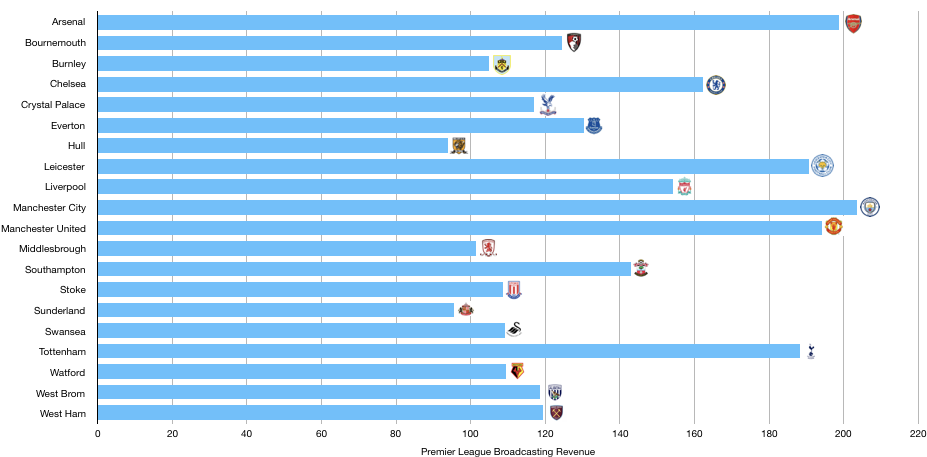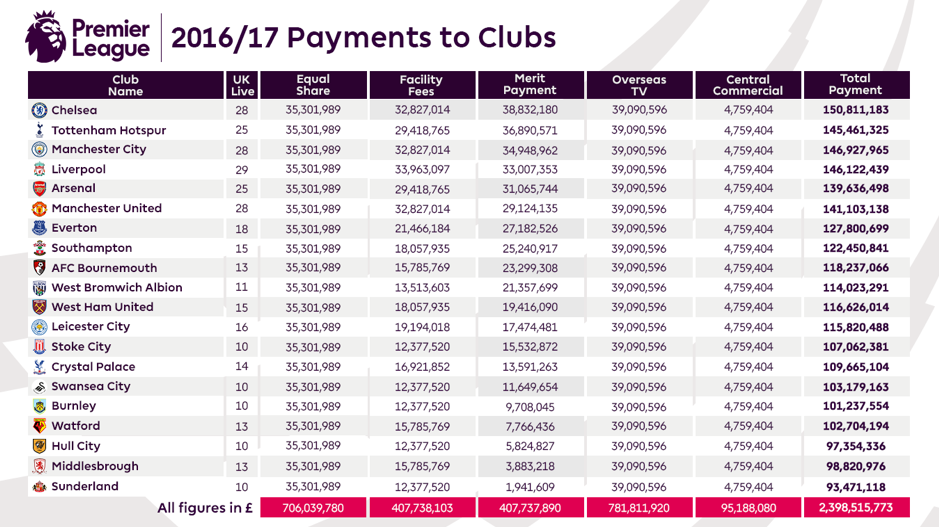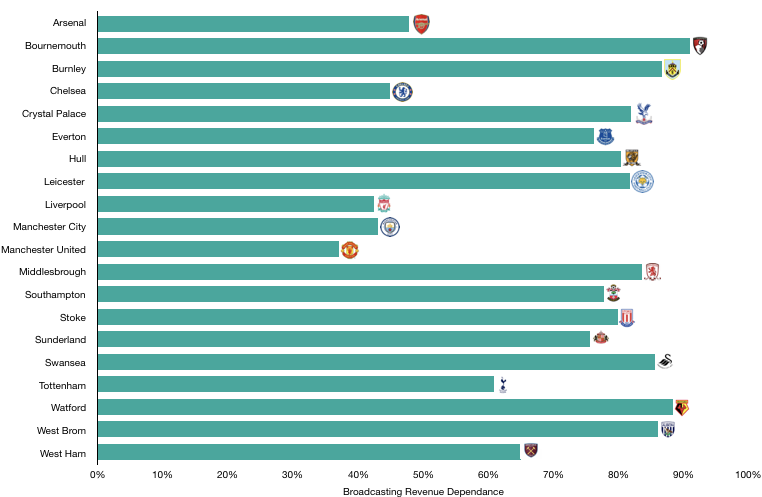The Premier League is known as the richest league on the planet for a good reason – the income clubs gain from their Premier League status. Premier League clubs earned nearly £2.8bn in broadcasting revenue in the 2016/17 season, up 38% on last year’s £2bn.
This was primarily driven by Premier League TV revenue; however, it was also supplemented by European endeavours (despite early exits outside Leicester and Manchester United).
This article analyses the riches gained by Premier League club from broadcasting revenue, this includes all prize money earned as well as TV money.
Let’s delve into the numbers.

Premier League Money

Premier League clubs are desperate to survive in the world’s best league due to the riches available. In 2016, deals were signed with Sky and BT Sports by the Premier League for the most lucrative Broadcasting deals ever signed at £5.14bn for three seasons.
2016/17 was the first of these three seasons and unsurprisingly saw a big increase of 46% on last year’s payments by the Premier League. Only the three relegated clubs earned less than £100m and that was only just.
Premier League broadcasting revenue made up approximately 87% of Premier League clubs recorded broadcasting revenue with the vast majority relying on their Premier League status as their main income.
Premier League revenue is split into various parts by the Premier League:
Equal Share – 29%
Facility fees – 17%
Merit payments – 17%
Overseas TV – 33%
Central Commercial – 4%
Equal share, Overseas TV and Central commercial are split evenly between all Premier League clubs and this makes up 56% of the Premier League money, much to the chagrin of the top 6 who want a larger share to themselves based on their league position and continue to lobby for this to happen, targeting a larger share of the Overseas TV money due to their international appeal.
So, the major differences in Premier League TV money are derived from merit payments and facility fees.
Merit payments are solely down to league position and fall roughly £2m per position starting at just under £39m going to just under a measly £2m for the bottom club this year, a huge £37m difference between Chelsea (the champions) and Sunderland (20th).
Facility fees are payments derived by the number of TV games showed and for the ‘usage’ of the club’s facilities. This is roughly £1.17m per game televised on Sky Sports or BT Sports. This usually favours the larger clubs as they have larger fan bases usually which brings more viewers to each channel.
However, clubs near the bottom can gain from being shown during their desperate relegation battle, with Middlesbrough shown 30% more than Stoke who finished 6 places above them. The top 4 battle and attractive high-octane style of Jurgen Klopp’s Liverpool saw them shown a record 29 times out of their 38 games to gain the most from facility fees.
Tottenham suffered on this scale despite finishing second and as such only gained the 4thmost Premier League TV money despite their second-place finish, falling behind Manchester City and Liverpool.
Facility fees are a huge differential between the top 6 and the rest of the Premier League, with the top 6 accounting for 47% of the facility fees due to their TV appearances, a similar future distribution of Overseas TV money would make the difference in TV money even greater.
Broadcasting Revenue: The Other Competitions

The majority of Premier League clubs earn the majority of their broadcasting revenue from their Premier League payments with 87% earned in this manner on average. Only 6 clubs had a % below 92%, with one of those names a surprise.
The other sources of broadcasting revenue are the Champions League, Europa League, FA Cup and League Cup, in order of the riches available.
Premier League clubs had a poor season in Europe with only Leicester and Manchester United impressing with early exits from the other big guns.
FA Cup revenue can also bring additional income with this discussed in more detail by use here, with the winner expected to pocket a total of around £6m with Arsenal the lucky recipient.
Leicester who more than doubled their broadcasting revenue only derived 61% of their revenue from the Premier League as compared to their Premier League winning campaign, with the extra Champions League revenue hugely boosting their earnings.
All the Champions league entrants derived less than 75% of their revenue from the Premier League as they were boosted by their lucrative European exploits, despite their lack of success.
Manchester United’s Europa League winning campaign netted the club over £40m in additional revenue as they earned more than the majority of the Premier League’s Champions League participants due to their early exits. Manchester United also gained earnings from winning the League Cup.
Southampton surprisingly were the 6thteam to derive less than 92% of their revenue from the Premier League despite exiting the Europa League at the group stages as their run to the League Cup final boosted earnings, despite only receiving £50k for their place in the final – however TV money from its showing will have been significantly more than that.
Broadcasting Dependence

We picked broadcasting revenue as the first income source to analyse due to its importance to all of the Premier League clubs. 71% of top flight club’s revenue is from broadcasting revenue showcasing club’s reliance on this for income. Only the top 6 and West Ham are below 65% due to their abilities to attract high matchday and most importantly commercial income.
Manchester United are unsurprisingly the least dependant due to their global status, earning only 33% of their revenue from broadcasting income. The commercial success of the Red Devils is unparalleled in the UK with Manchester City (43%) looking to catch up in this area.
Arsenal (48%), Chelsea (45%) and Liverpool (42%) are the only other clubs to have a reliance below 50%. This will worry Tottenham fans who at 61% will be hoping Daniel Levy is working on a strategy to reduce this by boosting their revenue from other sources, an area Tottenham lag their rivals.
On the other side is Bournemouth at 91% reliance who, due to their tiny stadium, are unable to generate anywhere near as much income from matchdays whilst they also struggle commercially as most teams outside the top 6 and the traditional old school big clubs (Newcastle and West Ham).
The sheer dependence on broadcasting revenue is the reason owners get out their trigger finger and sack their managers early in order to attempt to survive the jaws of relegation that will cost the club so dearly.
Thanks for reading, Share with a fellow football fan!

